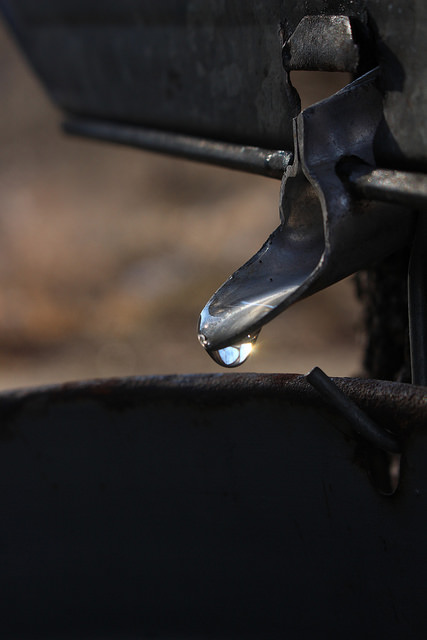I have started the early seeds inside – onions, leeks, celeriac. The indoor herbs are started too, and the lemon tree I got last year opened its first flower. Remarkably fragrant, one flower perfumed the entire room. Spring is just around the corner, but one of the favorite activities of winter isn’t quite finished.
With the warm, sunny days this past weekend, the maple sap began to flow again for the first time in almost a month. We tap our dozen trees a bit earlier than most, in mid-January. We are up on a hill on the southern side so it seems to run a bit earlier. Also, we have a lot of other things to do in March so if we’re done by then, we aren’t sad.
This year we are turning a bit of the syrup into sugar. Why? It is time consuming, not economically profitable, and messy. And isn’t syrup worth more as syrup? To some people, perhaps. But we have made what we need for the year, and the sap still flows. And it is pretty darn cool to have granulated sugar that came from the backyard.

Maple tap dripping with sap.
That’s really the driving reason behind most of what we do. I bet some of you are shaking your heads, I know my mother is as she mutters “expecting the end of the world, are you?” No, not really. I just like knowing that I can provide what I need. Sugar is a part of that.
Additionally, I think of the savings from an earthly point of view. The maple sap from the backyard travels a maximum of 300 feet from tree to sugar shack. It cooks to syrup using wood from trees within a mile. We do use a gas stove to render it to sugar, in the house just a few feet away. It’s put into mason jars, many of which are from relatives and have been around for decades. So the sugar traveled less than a quarter mile, the fuel traveled perhaps a mile, and the resources to process it were miniscule. And the ashes from the woodstove? Well, we spread those nutrients back under the trees for next year.
Compared to cane sugar, let’s say generously grown and processed in Florida, (most of it is farther away than that) the associated costs are tremendous. Fuel costs, pollution, electricity, transportation, labor, insurance, overhead and so forth are half of it. Growing it on plantations might involve herbicide, pesticide, machinery maintenance and fuel, fertilizer, and even if it is organic there are still agricultural inputs. Then the packaging, printing, and shipping costs. Frankly, it is remarkable that it is as cheap as it is.
We make maple sugar because it isn’t just about us. And certainly not about money. There is an entire network of living and non-living natural elements affected by every action humans make. I want to make that impact as small and beneficial as I can. If that means spending a weekend making sugar, so be it. The land and we are healthier for it.
Not to mention, it tastes better. White sugar is bleached, stripped of any mineral goodness. Maple sugar contains trace minerals including calcium, potassium, magnesium, phosphorus, and zinc, is a good source of manganese, and also has omega-6 fatty acids. Not too bad from the backyard.
There are so many things that people can do to make lives better, both their own and rest of the living world around them. It is nigh impossible to live completely locally in this day and age, but you can start somewhere. Local food, even growing or making some yourself is a good place to start. Visit a sugar house, there is still a bit of time left this year. See the first part of the process, maybe even help collect sap. Maybe even take a bit of syrup and turn it into sugar. It is a beautiful and mesmerizing process with a tasty result.
Audubon Community Nature Center builds and nurtures connections between people and nature. ACNC is located just east of Route 62 between Warren and Jamestown. The trails are open from dawn to dusk as is Liberty, the Bald Eagle. The Nature Center is open from 10 a.m. until 4:30 p.m. daily except Sunday when it opens at 1 p.m. More information can be found online at auduboncnc.org or by calling (716) 569-2345.


Recent Comments